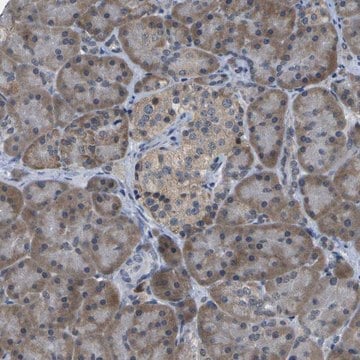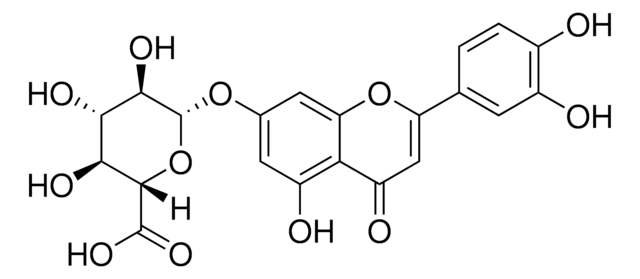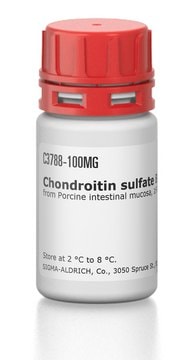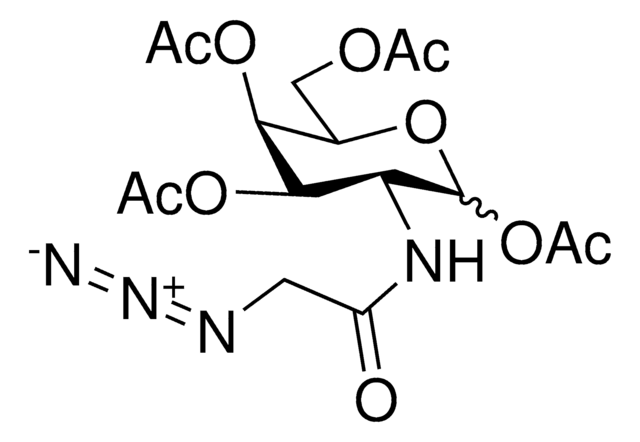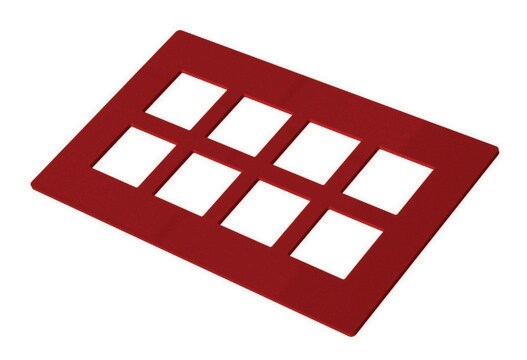推荐产品
生物源
mouse
品質等級
抗體表格
purified antibody
抗體產品種類
primary antibodies
無性繁殖
373E1, monoclonal
分子量
observed mol wt ~N/A kDa
純化經由
affinity chromatography
物種活性
chicken, human
物種活性(以同源性預測)
vertebrates
包裝
antibody small pack of 100
技術
ELISA: suitable
immunohistochemistry: suitable
immunoprecipitation (IP): suitable
western blot: suitable
同型
IgMκ
Protein ID登錄號
UniProt登錄號
儲存溫度
-10 to -25°C
特異性
Clone 373E1 is a mouse monoclonal antibody that detects Keratan sulfate in cartilage tissue.
免疫原
Purified proteoglycans from embryonic chicken.
應用
Quality Control Testing
Evaluated by Immunohistochemistry (Paraffin) in Human cartilage tissue sections.
Immunohistochemistry (Paraffin) Analysis: A 1:50 dilution of this antibody detected Keratan Sulfate in human cartilage tissue sections.
Tested Applications
Western Blotting Analysis: A representative lot detected Keratan Sulfate in Western Blotting application (Magro, G., et al. (2003). Am J Pathol. 163(1):183-96).
Immunoprecipitation Analysis: A representative lot immunoprecipitated Keratan Sulfate in Immunoprecipitation application (Magro, G., et al. (2003). Am J Pathol. 163(1):183-96).
Immunohistochemistry Applications: A representative lot detected Keratan Sulfate in Immunohistochemistry application (Magro, G., et al. (2003). Am J Pathol. 163(1):183-96).
ELISA Analysis: A representative lot detected Keratan Sulfate in ELISA application (Magro, G., et al. (2003). Am J Pathol. 163(1):183-96).
Note: Actual optimal working dilutions must be determined by end user as specimens, and experimental conditions may vary with the end user.
Evaluated by Immunohistochemistry (Paraffin) in Human cartilage tissue sections.
Immunohistochemistry (Paraffin) Analysis: A 1:50 dilution of this antibody detected Keratan Sulfate in human cartilage tissue sections.
Tested Applications
Western Blotting Analysis: A representative lot detected Keratan Sulfate in Western Blotting application (Magro, G., et al. (2003). Am J Pathol. 163(1):183-96).
Immunoprecipitation Analysis: A representative lot immunoprecipitated Keratan Sulfate in Immunoprecipitation application (Magro, G., et al. (2003). Am J Pathol. 163(1):183-96).
Immunohistochemistry Applications: A representative lot detected Keratan Sulfate in Immunohistochemistry application (Magro, G., et al. (2003). Am J Pathol. 163(1):183-96).
ELISA Analysis: A representative lot detected Keratan Sulfate in ELISA application (Magro, G., et al. (2003). Am J Pathol. 163(1):183-96).
Note: Actual optimal working dilutions must be determined by end user as specimens, and experimental conditions may vary with the end user.
標靶描述
Keratan sulfate (also known as keratosulfate) is a widely distributed glycosaminoglycan in tensional and weight-bearing connective tissues, epithelial tissues, and the central and peripheral nervous system. It is attached to a number of proteoglycan and glycoprotein core proteins. Three types of keratan sulfate have been described: KS I, KS II, and KS III depending on their distribution pattern. Keratan sulfate is the only glycosaminoglycan (GAG) that does not contain uronic acid; therefore, it is not cleavable by the eliminative enzymatic cleavage. The biosynthesis of keratan sulfate occurs in two stages. In the first stage, the region binding the core protein with GAG is created followed by the elongation of the chain and its modification. The elongation of keratan sulfate chains of all types occurs by alternate attaching of Gal and GlcNAc residues, catalyzed by β-1,4-galactotransferase and β-1,3-N-acetyloglucosaminotransferase, respectively. Sulfation of keratan sulfate is carried out by at least two sulfotransferases. Gal 6-O-sulfotransferase transfers sulfate to position 6 of Gal residues located in the internal region of keratan sulfate and GlcNAc 6-O-sulfotransferase transfers sulfate to position 6 of GalNAc residues located at the nonreducing terminal of keratan sulfate. Clone 373E1 is a monoclonal antibody that detects a unique sialylation/ conformational-dependent KS epitope that detects a novel glycoprotein complex produced by papillary thyroid carcinoma cells. (Ref.: Magro, G., et al. (2003) Am. J. Pathol. 163(1); 183-196; Caterson, B., et al. (1982). J. Invest. Dermatol. 79 (suppl 1); 45-50; Coleman, PJ., et al. (1998). J. Physiol. 509(3); 695-710).
外觀
Purified mouse monoclonal antibody IgM in PBS without preservatives.
重構
1.0 mg/mL. Please refer to guidance on suggested starting dilutions and/or titers per application and sample type.
儲存和穩定性
Store at -10°C to -25°C. Handling Recommendations: Upon receipt and prior to removing the cap, centrifuge the vial and gently mix the solution. Aliquot into microcentrifuge tubes and store at -20°C. Avoid repeated freeze/thaw cycles, which may damage IgG and affect product performance.
其他說明
Concentration: Please refer to the Certificate of Analysis for the lot-specific concentration.
免責聲明
Unless otherwise stated in our catalog or other company documentation accompanying the product(s), our products are intended for research use only and are not to be used for any other purpose, which includes but is not limited to, unauthorized commercial uses, in vitro diagnostic uses, ex vivo or in vivo therapeutic uses or any type of consumption or application to humans or animals.
未找到合适的产品?
试试我们的产品选型工具.
儲存類別代碼
12 - Non Combustible Liquids
水污染物質分類(WGK)
WGK 2
閃點(°F)
Not applicable
閃點(°C)
Not applicable
我们的科学家团队拥有各种研究领域经验,包括生命科学、材料科学、化学合成、色谱、分析及许多其他领域.
联系技术服务部门
